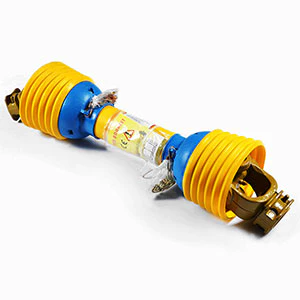The power output shaft (PTO shaft) is an indispensable power transmission component in agricultural machinery, engineering equipment, and industrial equipment. It realizes the function of the equipment by transmitting the power of the engine to the auxiliary equipment (such as pumps, compressors, harvesters, etc.). However, due to the long-term high-load and high-speed working state of the PTO shaft, coupled with the influence of the external environment (such as dust, mud, high temperature, etc.), various faults are prone to occur. If it is not repaired or replaced in time, it will not only affect the working efficiency of the equipment but also may cause more serious mechanical damage.
PTO Shaft Common Faults and Detailed Repair Methods
1. Bending or Deformation of the PTO Shafts
Cause Analysis
- High-load operation: Under prolonged high-load operation, the PTO shaft may bend as a result of unequal stress.
- External impact: During operation, the PTO shaft may be deformed due to collision with hard objects or external impact.
- Improper installation: If the PTO shaft is not aligned or securely fastened during installation, it may also result in shaft deformation.
Maintenance Method
- Check the shaft: Carefully measure the straightness of the shaft using a micrometer or laser alignment tool. Determine if it is bent and how far out of proper alignment it is.
- Repair the shaft: If the bend is minimal, use a hydraulic alignment machine to gently straighten it. However, if the bend is severe, it is best to replace the shaft completely.
- Reinstall with Care: When putting the PTO shaft back in place, make sure it is perfectly aligned with the drive and driven equipment. Taking the time to install it properly will help prevent any further damage or problems.
2. Bearing Damage
Cause Analysis
- Insufficient lubrication: Lack of lubricating oil in the bearing will increase friction, resulting in high temperature and wear.
- Impurity intrusion: Impurities such as dust and mud entering the bearing will accelerate the wear of the bearing.
- Bearing aging: After long-term use, the ball or raceway of the bearing may suffer fatigue damage.
Maintenance Method
- Disassembly inspection: Remove the PTO shaft housing and check whether the bearing is worn, cracked, or stuck.
- Replace the bearing: If the bearing is damaged, use special tools to remove the old bearing and install a new one. Pay attention to choosing accessories that are consistent with the original bearing model.
- Lubrication and maintenance: After installing the new bearing, add an appropriate amount of high-temperature grease and check the lubrication condition regularly.

3. Coupling Wear or Damage
Cause Analysis
- Long-term friction: The coupling will be subjected to greater friction during power transmission and may wear after long-term use.
- Material problem: Low-quality couplings are easily damaged due to insufficient strength.
- Poor alignment: If the PTO shaft and the drive device are poorly aligned, the coupling will be unevenly stressed and wear will be accelerated.
Maintenance Method
- Check the coupling: Remove the coupling and check whether there are cracks, wear, or deformation on its surface.
- Replace the coupling: If the coupling is damaged, replace it with a new one. It is recommended to choose a high-strength, wear-resistant material.
- Alignment adjustment: After installing the new coupling, use a laser alignment instrument or dial indicator to adjust the alignment of the PTO shaft and the drive device to ensure smooth power transmission.
4. Seal Failure
Cause Analysis
- Seal aging: Rubber seals are prone to hardening and cracking after high temperature and long-term use.
- Improper installation: Seals are misaligned or squeezed during installation, which may cause seal failure.
- External pollution: Impurities such as dust and mud invade the inside of the seal, which will accelerate its damage.
Repair Method
- Check the seal: Remove the PTO shaft housing and check whether the seal has cracks, deformation, or hardening.
- Replace the seal: If the seal fails, replace it with a new one. Pay attention to choosing high-quality seals that are resistant to high temperature and wear.
- Clean installation: Before installing a new seal, clean the seal groove and contact surface to ensure that there are no impurities left. Use special tools during installation to avoid deformation of the seal.

5. Spline Wear
Cause Analysis
- Long-term friction: Splines will be subjected to greater friction during power transmission and may wear after long-term use.
- Insufficient lubrication: Lack of lubrication on the spline will increase friction and accelerate wear.
- Poor alignment: If the PTO shaft and the drive device are not aligned properly, the spline will be unevenly stressed and wear will be accelerated.
Repair Method
- Check the spline: Remove the PTO shaft and check whether the spline is worn, deformed, or cracked.
- Repair or replace: For slightly worn splines, you can use a file or sandpaper to repair; if the wear is serious, you need to replace a new shaft.
